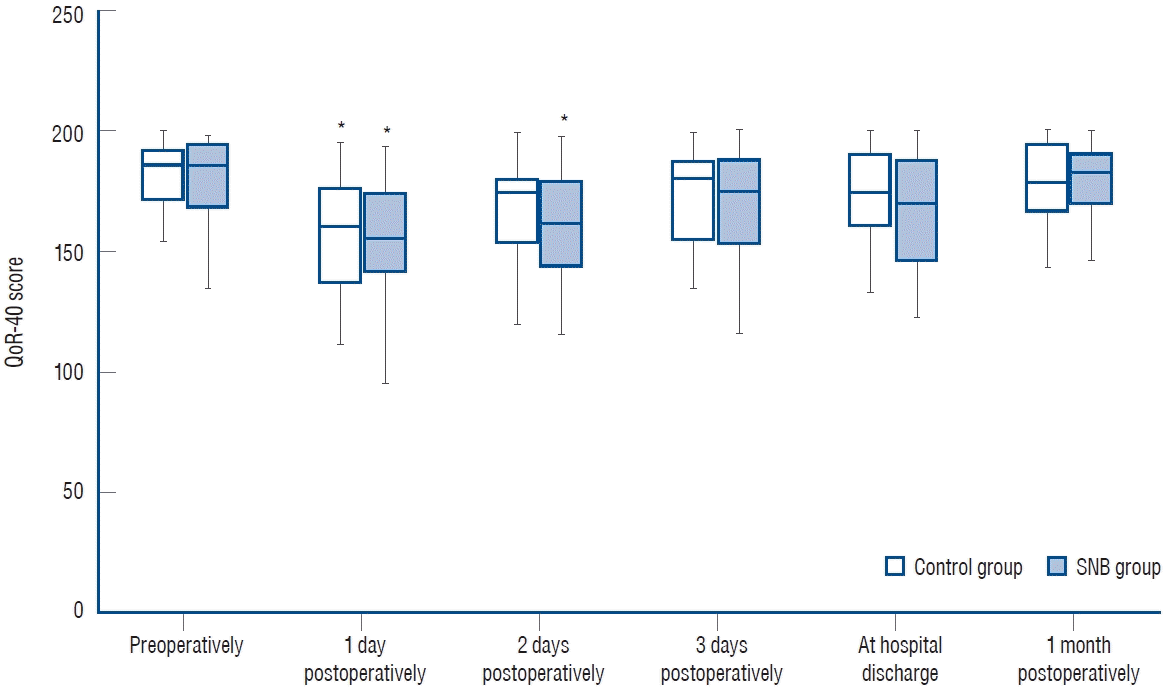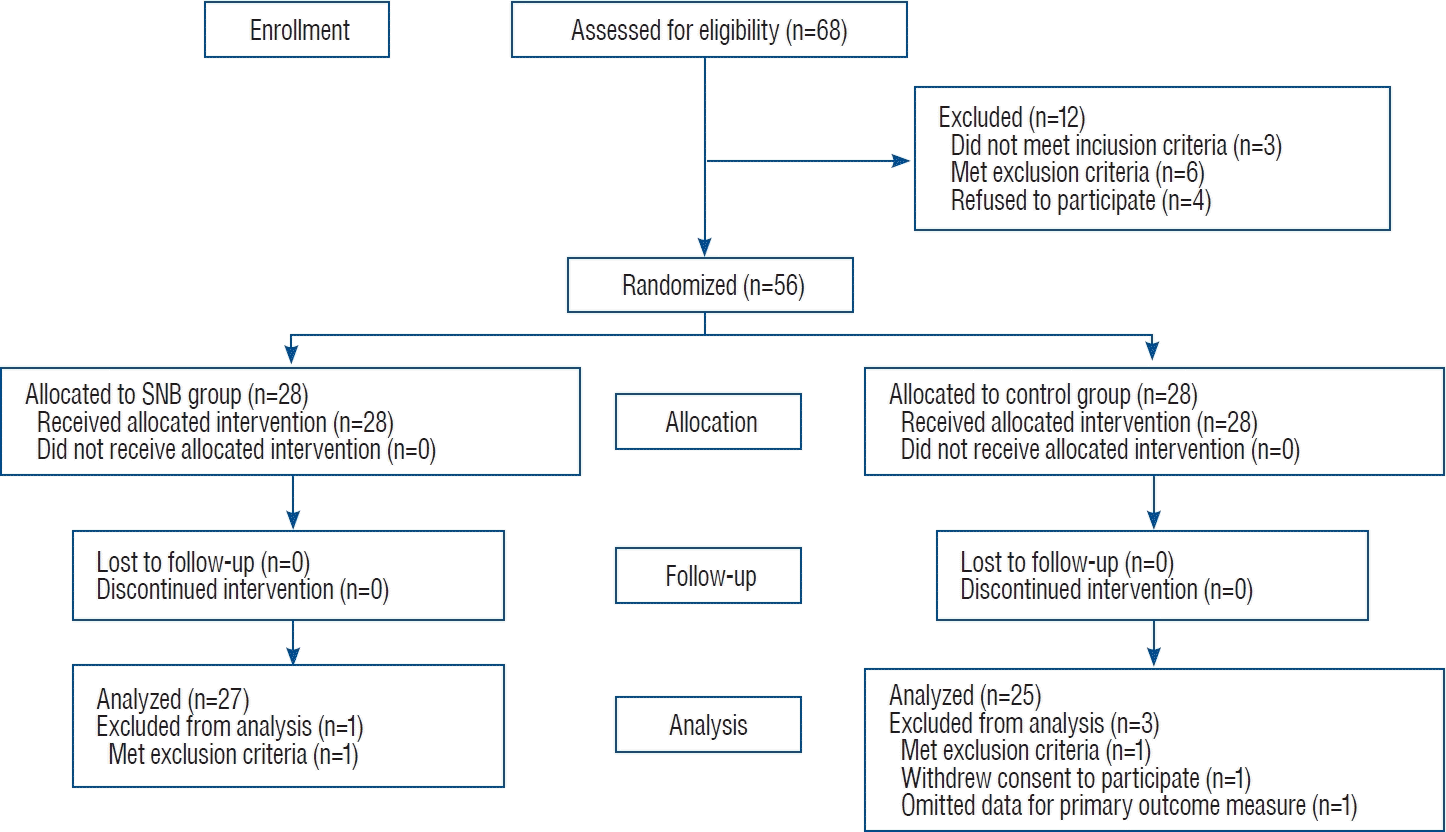1. Akcil EF, Dilmen OK, Vehid H, Ibisoglu LS, Tunali Y. Which one is more effective for analgesia in infratentorial craniotomy? The scalp block or local anesthetic infiltration. Clin Neurol Neurosurg. 154:98–103. 2017.

2. Akhigbe T, Zolnourian A. Use of regional scalp block for pain management after craniotomy: review of literature and critical appraisal of evidence. J Clin Neurosci. 45:44–47. 2017.

3. Altman AD, Helpman L, McGee J, Samouëlian V, Auclair MH, Brar H, et al. Enhanced recovery after surgery: implementing a new standard of surgical care. CMAJ. 191:E469–E475. 2019.

4. Apfel CC, Kranke P, Eberhart LH, Roos A, Roewer N. Comparison of predictive models for postoperative nausea and vomiting. Br J Anaesth. 88:234–240. 2002.

5. Batoz H, Verdonck O, Pellerin C, Roux G, Maurette P. The analgesic properties of scalp infiltrations with ropivacaine after intracranial tumoral resection. Anesth Analg. 109:240–244. 2009.

6. Bowyer AJ, Royse CF. Postoperative recovery and outcomes--what are we measuring and for whom? Anaesthesia. 71 Suppl 1:72–77. 2016.
7. Chatterjee S, Rudra A, Sengupta S. Current concepts in the management of postoperative nausea and vomiting. Anesthesiol Res Pract. 2011:748031. 2011.

8. Cho WS, Kim JE, Kang HS, Son YJ, Bang JS, Oh CW. Keyhole approach and neuroendoscopy for cerebral aneurysms. J Korean Neurosurg Soc. 60:275–281. 2017.

9. de Gray LC, Matta BF. Acute and chronic pain following craniotomy: a review. Anaesthesia. 60:693–704. 2005.

10. Echeverria-Villalobos M, Stoicea N, Todeschini AB, Fiorda-Diaz J, Uribe AA, Weaver T, et al. Enhanced recovery after surgery (ERAS): a perspective review of postoperative pain management under ERAS pathways and its role on opioid crisis in the United States. Clin J Pain. 36:219–226. 2020.
11. Elayat A, Jena SS, Nayak S, Sahu RN, Tripathy S. "Enhanced recovery after surgery - ERAS in elective craniotomies-a non-randomized controlled trial". BMC Neurol. 21:127. 2021.

12. Flexman AM, Ng JL, Gelb AW. Acute and chronic pain following craniotomy. Curr Opin Anaesthesiol. 23:551–557. 2010.

13. Gan TJ. Poorly controlled postoperative pain: prevalence, consequences, and prevention. J Pain Res. 10:2287–2298. 2017.

14. Gornall BF, Myles PS, Smith CL, Burke JA, Leslie K, Pereira MJ, et al. Measurement of quality of recovery using the QoR-40: a quantitative systematic review. Br J Anaesth. 111:161–169. 2013.

15. Gottschalk A, Yaster M. The perioperative management of pain from intracranial surgery. Neurocrit Care. 10:387–402. 2009.

16. Hong N, Cho WS, Pang CH, Choi YH, Bae JW, Ha EJ, et al. Treatment outcomes of 1-stage clipping of multiple unruptured intracranial aneurysms via keyhole approaches. J Neurosurg. 136:475–484. 2021.

17. Hwang JY, Bang JS, Oh CW, Joo JD, Park SJ, Do SH, et al. Effect of scalp blocks with levobupivacaine on recovery profiles after craniotomy for aneurysm clipping: a randomized, double-blind, and controlled study. World Neurosurg. 83:108–113. 2015.

18. Janis JE, Hatef DA, Thakar H, Reece EM, McCluskey PD, Schaub TA, et al. The zygomaticotemporal branch of the trigeminal nerve: part II. Anatomical variations. Plast Reconstr Surg. 126:435–442. 2010.

19. Lee JH, Ki M, Choi S, Woo CJ, Kim D, Lim H, et al. Validity and reliability of the Korean version of the quality of recovery-15 questionnaire. Korean J Anesthesiol. 74:142–149. 2021.

20. Lee JH, Kim D, Seo D, Son JS, Kim DC. Validity and reliability of the Korean version of the quality of recovery-40 questionnaire. Korean J Anesthesiol. 71:467–475. 2018.

21. Leslie K, Troedel S, Irwin K, Pearce F, Ugoni A, Gillies R, et al. Quality of recovery from anesthesia in neurosurgical patients. Anesthesiology. 99:1158–1165. 2003.

22. Liu B, Liu S, Wang Y, Zhao B, Zhao T, Zhao L, et al. Neurosurgical enhanced recovery after surgery (ERAS) programme for elective craniotomies: are patients satisfied with their experiences? A quantitative and qualitative analysis. BMJ Open. 9:e028706. 2019.

23. Liu B, Liu S, Zheng T, Lu D, Chen L, Ma T, et al. Neurosurgical enhanced recovery after surgery ERAS for geriatric patients undergoing elective craniotomy: a review. Medicine (Baltimore). 101:e30043. 2022.

24. Mancel L, Van Loon K, Lopez AM. Role of regional anesthesia in enhanced recovery after surgery (ERAS) protocols. Curr Opin Anaesthesiol. 34:616–625. 2021.

25. Myles PS, Weitkamp B, Jones K, Melick J, Hensen S. Validity and reliability of a postoperative quality of recovery score: the QoR-40. Br J Anaesth. 84:11–15. 2000.

26. Osborn I, Sebeo J. "Scalp block" during craniotomy: a classic technique revisited. J Neurosurg Anesthesiol. 22:187–194. 2010.

27. Park J. Superciliary keyhole approach for unruptured anterior circulation aneurysms: surgical technique, indications, and contraindications. J Korean Neurosurg Soc. 56:371–374. 2014.

28. Park J. Supraorbital keyhole approach for intracranial aneurysms : transitioning from concerns to confidence. J Korean Neurosurg Soc. 63:4–13. 2020.

29. Park JS, Kwon MY, Lee CY. Minipterional craniotomy for surgical clipping of anterior circulation aneurysms: compatibility between the feasibility, safety and efficiency. J Cerebrovasc Endovasc Neurosurg. 22:65–77. 2020.

30. Royse CF, Newman S, Chung F, Stygall J, McKay RE, Boldt J, et al. Development and feasibility of a scale to assess postoperative recovery: the post-operative quality recovery scale. Anesthesiology. 113:892–905. 2010.

31. Sato K, Sai S, Adachi T. Is microvascular decompression surgery a high risk for postoperative nausea and vomiting in patients undergoing craniotomy? J Anesth. 27:725–730. 2013.

32. Sato T, Nishiwaki K. Accuracy of landmark scalp blocks performed during asleep-awake-asleep awake craniotomy: a retrospective study. JA Clin Rep. 7:8. 2021.

33. Stark PA, Myles PS, Burke JA. Development and psychometric evaluation of a postoperative quality of recovery score: the QoR-15. Anesthesiology. 118:1332–1340. 2013.

34. Stumpo V, Staartjes VE, Quddusi A, Corniola MV, Tessitore E, Schröder ML, et al. Enhanced recovery after surgery strategies for elective craniotomy: a systematic review. J Neurosurg. 135:1857–1881. 2021.

35. Thompson BG, Brown RD Jr, Amin-Hanjani S, Broderick JP, Cockroft KM, Connolly ES Jr, et al. Guidelines for the management of patients with unruptured intracranial aneurysms: a guideline for healthcare professionals from the American Heart Association/American Stroke Association. Stroke. 46:2368–2400. 2015.

36. Totonchi A, Pashmini N, Guyuron B. The zygomaticotemporal branch of the trigeminal nerve: an anatomical study. Plast Reconstr Surg. 115:273–277. 2005.

37. Tsan SEH, Goh CH, Tan PCS. Ultrasound-guided scalp blocks for an awake craniotomy: a case report. A A Pract. 16:e01618. 2022.

38. Uribe AA, Stoicea N, Echeverria-Villalobos M, Todeschini AB, Esparza Gutierrez A, Folea AR, et al. Postoperative nausea and vomiting after craniotomy: an evidence-based review of general considerations, risk factors, and management. J Neurosurg Anesthesiol. 33:212–220. 2021.

39. Wang L, Cai H, Wang Y, Liu J, Chen T, Liu J, et al. Enhanced recovery after elective craniotomy: a randomized controlled trial. J Clin Anesth. 76:110575. 2022.

40. Wong JH, Tymianski R, Radovanovic I, Tymianski M. Minimally invasive microsurgery for cerebral aneurysms. Stroke. 46:2699–2706. 2015.

41. Yang X, Ma J, Li K, Chen L, Dong R, Lu Y, et al. A comparison of effects of scalp nerve block and local anesthetic infiltration on inflammatory response, hemodynamic response, and postoperative pain in patients undergoing craniotomy for cerebral aneurysms: a randomized controlled trial. BMC Anesthesiol. 19:91. 2019.

42. Yang Y, Ou M, Zhou H, Tan L, Hu Y, Li Y, et al. Effect of scalp nerve block with ropivacaine on postoperative pain in patients undergoing craniotomy: a randomized, double blinded study. Sci Rep. 10:2529. 2020.

43. Yoon S, Joo H, Oh YM, Lee J, Bahk JH, Lee HJ. Validation and clinical utility of the Korean version of the quality of recovery-15 with enhanced recovery after surgery: a prospective observational cohort study. Br J Anaesth. 125:614–621. 2020.

44. Zetlaoui PJ, Gauthier E, Benhamou D. Ultrasound-guided scalp nerve blocks for neurosurgery: a narrative review. Anaesth Crit Care Pain Med. 39:876–882. 2020.

45. Zheng L, Hagan KB, Villarreal J, Keerty V, Chen J, Cata JP. Scalp block for glioblastoma surgery is associated with lower inflammatory scores and improved survival. Minerva Anestesiol. 83:1137–1145. 2017.






 PDF
PDF Citation
Citation Print
Print




 XML Download
XML Download